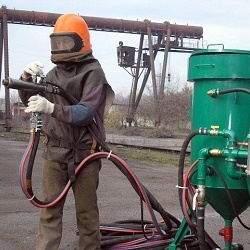Choosing a pumping station for a private house
Any detached residential or industrial building requires installation of engineering life support equipment. The problem of water supply in villages that do not have a centralized system is solved with the help of a well or an individual artesian well, the water from which is supplied by a pumping station for a private house. It takes up minimal space and works, without requiring the constant attention of the residents. At the same time, all sanitary appliances function as usual, providing the necessary comfort of living.
Content
Purpose and principle of operation of the pumping station
A typical home pumping station is an assembled unit for water supply of various objects.It is connected with a hose or suction pipe to a source of clean water, which is fed through high-pressure pipes to all water points.
The station is powered by a home electrical network and shows a very economical power consumption. Its task is to automatically maintain a certain pressure in the pressure pipe. At the same time constant operation of the pump is not required. He in a short time, pumps a certain amount of fluid in special water tankfrom which it is gradually being analyzed for domestic needs.
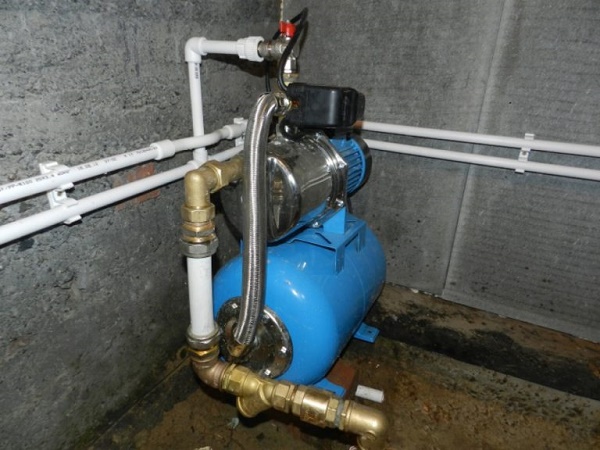
The state of the system monitors Control block, the purpose of which is to issue commands to start and stop the pump. To increase the water pressure, it is necessary that it reaches a predetermined minimum value. This closes the electrical circuit and turns on the engine. Its shutdown occurs at the time of reaching the maximum. The consumer may not care about the condition of the equipment, using water at any time of the day.
The main elements of the pumping station
The device of the pumping station is simple and reliable. Old schemes with bulk storage tankinstalled at high altitude are almost not used, since they are cumbersome and difficult to install. Modern systems are equipped with a compact hydroaccumulator with an integrated membrane to create a springy air cushion, which turned out to be more convenient from a technical point of view. It is air that contributes to the long-term maintenance of the necessary pressure of water during its consumption.
Structurally, the pumping station consists of:
- centrifugal pump with electric motor;
- the hydroaccumulator divided by a rubber partition on water and air space;
- fine filter;
- control unit, which includes a pressure gauge, pressure control relay and sensor dry running.
- hose and piping systems with valves used to shut off equipment during the audit and repair period.

If the water source is located at a shallow depth and in the immediate vicinity of the pump, a check valve and a coarse filter are installed in the well in the suction pipe.
Receivers are used at low fluid levels. outboard ejectorresponsible for the steady flow of water to the surface.
Classification of pumping stations
Pumping stations may have a different device and arrangement of elements. At the place of installation of the pump distinguish the following types of equipment:
- systems with submersible pump;

- surface pumping stations.
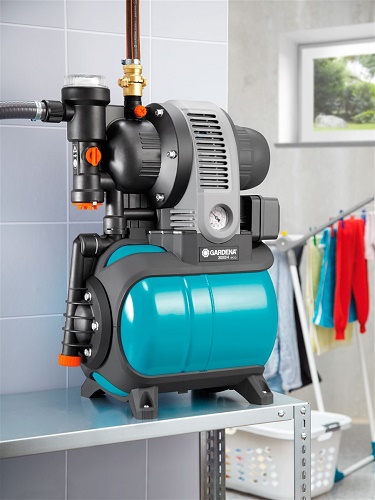
The first of them are able to lift water from deep wells and have absolutely no noise impact on the inhabitants of the house. The latter are more common. They have a pump unit located on the same frame with a hydroaccumulator. They are usually installed in a caisson or in a separate room at home. They are convenient in installation and operation.
For surface pumps, the most important characteristic is suction depth It is capable of increasing its small injection installation, which can be placed:
- in the well;
- on the receiving pipeline directly in front of the pump.
Submersible ejector system is silent, able to lift a water column from a great depth, but is characterized by low efficiency. Self-priming hydraulic installation, coupled with the pump, publishes a characteristic hum and has a limit on the level of sustainable suction.Its quiet operation is possible only in a separate room with good noise insulation.
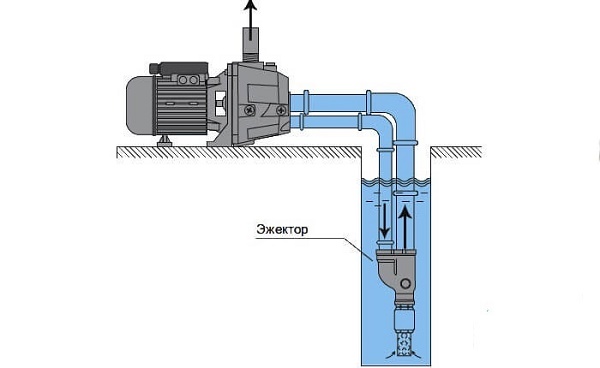
There is a classification of pumping stations by type of storage capacity. There are two types of water pumping stations:
- with a storage tank installed in the attic or in another high place with the distribution of water carried out by gravity;
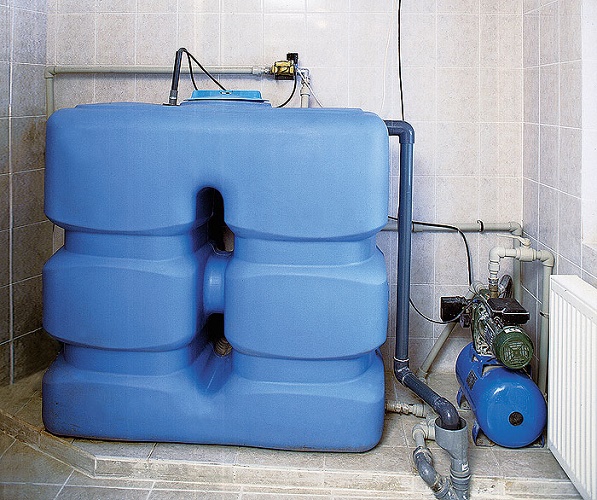
- with a diaphragm tank, designed to work with a pressure of about 2-5 atmospheres, which provides a good head, but requires the use of reliable automation.
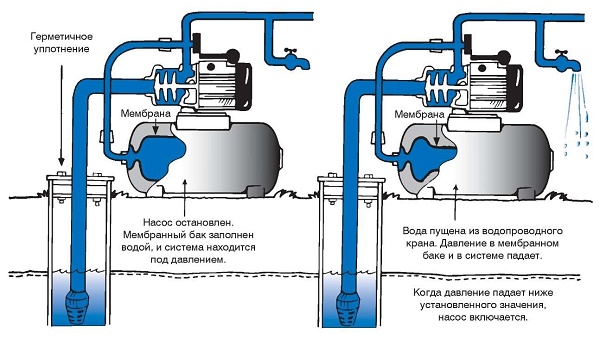
Important! Often there are situations when the centralized water supply pipeline approaches the building, but due to the large amount of water disassembly its pressure is not enough. This is especially noticeable in hours of intensive consumption. This problem can be eliminated with a booster or booster pumping station that connects to the pipe at the entrance to the facility.
In case of constant water consumption over a long period, it can be equipped for technical or domestic needs. pumping stationoperating in manual mode. In all other situations, the option of automatic water supply using a low-noise mini pumping station will be economically feasible.
The main approaches to the choice of pumping equipment for a private house
If you are going to choose a suitable station for an apartment or for a country house, it is necessary to clearly understand its working conditions and technical characteristics that it should satisfy. First of all, pay attention to the type of water source. The depth of the suction unit must be selected in accordance with the level of occurrence of the aquifer, taking into account the distance of the horizontal installation of the receiving pipeline. This question is closely related to the intended installation site of the pump.
The main parameters of the pumping station include:
- Top performance. Peak consumption for a family of 4-6 people living in a cottage rarely exceeds 1.5-2 m3/ hour, but there are exceptions related to the type and quantity of installed plumbing equipment and other water consumption devices.
- Head pressure. It should correspond to the height of installation of consumption devices taking into account the hydraulic resistance of pipelines.
- Motor power consumptiondirectly related to flow and pressure.
- Hydroaccumulator volumeOn which the frequency of switching on the pump depends. In most cases, for an individual house choose the capacity of 25-40 liters.
If the hydraulic calculation of the pumping station shows some reserve of possibilities, then it is better to install it in a convenient for maintenance. heated room. In the case of using deep wells, you will have to use a submersible pump or pick up a surface model with a remote ejector, equipping the caisson directly above the intake point.
Of great importance is the intended station operation mode. With rare inclusion it is better to buy a conventional pump for a water supply system with a manual start, but for ease of use, they often choose automated systems. They are somewhat more expensive, but they provide savings in running costs.

/rating_off.png)








